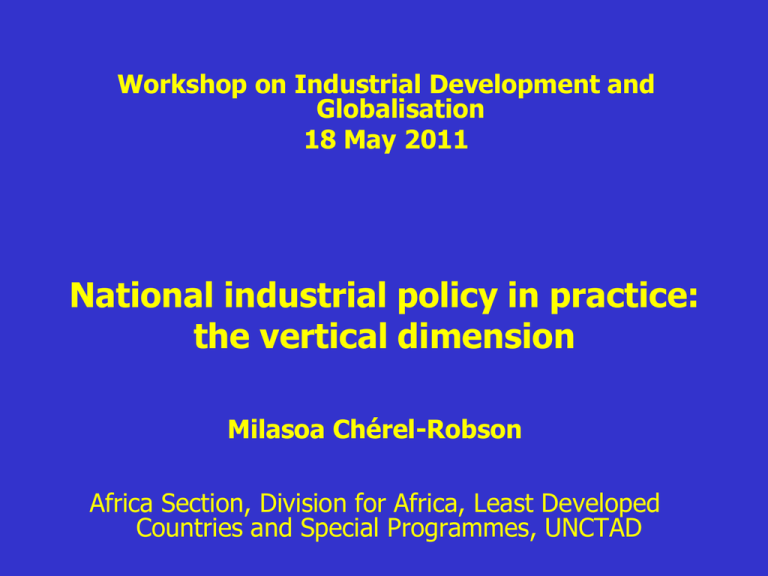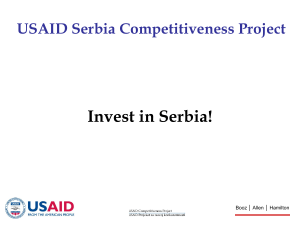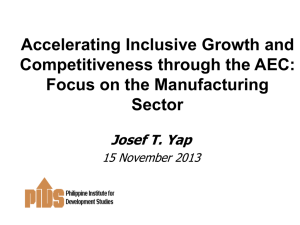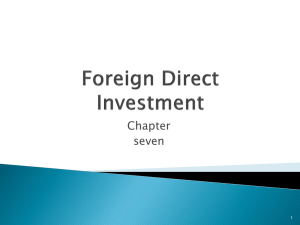Dar Course on Industrial Development and Globalisation
advertisement

Workshop on Industrial Development and Globalisation 18 May 2011 National industrial policy in practice: the vertical dimension Milasoa Chérel-Robson Africa Section, Division for Africa, Least Developed Countries and Special Programmes, UNCTAD Structure of the session I. Definition and duration of vertical policies II. Support to domestic products/sectors/subsectors: principles III. Selected measures to support domestic firms IV. FDI and industrial policy: principles V. FDI and industrial policy: instruments 3-4 minutes per slide including class discussion and questions. PREAMBLE: LEADERSHIP • The design, implementation and effectiveness of industrial policy depends on strong national leadership from the government in partnership with the private sector and civil society at large. • Africa has a strategic importance thanks to its natural resources. Hence should not shy away from being assertive in its policies. I. Definition and duration of vertical policies Key points: understanding the definition of vertical policies and how they differ from horizontal policies. Keeping in mind the importance of the temporary nature of vertical measures. I. Definition and duration of vertical policies (1) • Vertical policies refer to measures aimed at supporting specific products or industries (sectors/subsectors). Vertical policies are temporary. • Measures originally aimed to support specific sectors can be developed into policies that impact other sectors (more technologically sophisticated) of the economy and ultimately the whole economic system. Ex: the protection of the electronics and computer industry in LA shifted to supporting software, then ICTs and the promotion of the information society in the region. Definition and duration of vertical policies (2) • There is no formulae or a set of best practices that work for all cases. There are examples of vertical measures that aim to: – Supporting domestic firms in specific sectors for a well defined time period. – Attracting and policing FDI in specific sectors for a well defined time period. II. Support to domestic products/sectors/subsectors: principles and tradeoffs Key points: Understanding the key principles behind the choice of support for specific products/sectors/subsectors. Tradeoffs are necessary but simultaneous choices can also be made. II. Support to domestic products/sectors/subsectors: principles and tradeoffs (1) • Combine temporary protection with temporary subsidies • Instil principle of gradual technology upgrading through support of R&D • Strengthen government’s administrative and institutional capacity to implement and monitor these measures. Support to domestic products/sectors/subsectors: principles and tradeoffs (2) • For commodity producing countries commodity processing provides opportunities for early industrialisation but there are other possibilities that can be pursued simultaneously. • Evidence from analytical work strongly suggests that countries that delay industrialisation beyond commodity processing delay the opportunities for high income growth. Support to domestic products/sectors/subsectors: principles and tradeoffs (3) • Early stages of industrial development requires DIVERSIFICATION beyond exploitation of unskilled labour and natural resources into a wider array of more technologically advanced activities. • Sectoral specialisation happens again at a later stage of development.e.g. pc income of $9,000. • Priority should be given to choosing sectors with stronger linkages with other sectors of the economy. III. Selected measures to support domestic firms Key points: listing and discussion of a selection of measures targeted to specific products or sectors identified in industrial diagnosis analysis. First target: domestic firms. III. Selected measures to support domestic firms (1): TEMPORARY/TIME BOUND protection • Tariffs are used to protect a given industry and kept at their initial maximum level for a given time period. They can be brought down gradually until the industry matures. • These measures depend on government having policy flexibility/policy space to undertake them in the context of a growing trend for multilateral discipline. Selected measures to support domestic firms (2): access to finance • Subsidised credit, special credit lines favouring particular sectors and/or regions within the country • Finance for marketing • Finance for entire investment • Loan working capital • Financial mechanisms for leveraging funds: ex. guarantee funds. Selected measures to support domestic firms (3): access to markets Export markets used as a vent for surplus and opportunities to understand global demand. Support measures include: • Creation of a trade promotion agency • Export credit line at the development bank • Export credit insurance Selected measures to support domestic firms (4): technology upgrading (1) • Subsidies for research and innovation capacity • Promoting joint ventures with TNCs through contractual obligations • Creation or support of existing clusters and industrial parks. Support measures include providing infrastructure and special prices for power generation. Measures to support domestic firms (4): technology upgrading (2). Source: TDR 2006/Alkuz 2005 Timing of support to specific products Measures to support domestic firms (4): technology upgrading (3). • support policies follow a non-linear path; that is, any specific product category is a candidate for public support policies only for a limited period of time. • level of support required to move from mediumto high-technology intensive products will be lower than that required to move from traditional industries to MTintensive products. IV. FDI and industrial policy: principles Key points: core principles for the elaboration of a proactive FDI policy for development. IV. FDI and industrial policy: principles (1) • Evaluate the kind of externalities that FDI generates. • Embedd FDI policy in overall development strategy. • Success stories of impact of FDI on development based on building domestic absorptive capacity FDI and industrial policy: principles (2): economic development (1) • FDI generates economic development if there is an active government involvement for ensuring that it does result in technology transfer through the following: • Multinationals are linked with domestic firms • Domestic firms internalise the spillovers • domestic conditions support learning • Favouring types of FDI that add to the host country’s productive assets (ex: greenfield investment) IV. FDI and industrial policy: principles (3): economic development (2) • Most importantly: FDI generates economic development if there are strong linkages with key parts of the host economy. Figure 1: Linkages between MNEs and the home country economy (source: Rajneesh Narula, Henley, University of Reading) Beware of… • Excessive bias in attracting FDI generates the risk of external integration versus internal integration (Wade, 2003). • Risk of FDI strengthening the host country’s comparative advantage in natural resources and hence no upgrading. V. FDI and industrial policy: instruments Key points: Some instruments that can be used in attracting and managing FDI for development. Target: foreign firms. V. FDI and industrial policy: instruments (1) Attracting FDI based on locational advantages: • Export Processing Zones (EPZ) • Fiscal incentives such as specific tax breaks • Special trade agreements BUT these are vulnerable to competition from other countries based on costs FDI and industrial policy: instruments (2) Provide pecunary externalities to TNCs through: Support policies for the creation of a dense network of intermediate inputs suppliers of high quality inputs at competitive prices. Offer other auxilliary benefits. Class discussion: 1. on leadership: government and private sector. 2. which sectors in Tanzania have strong business associations? 3. what is the potential of these sectors for creating strong linkages with other parts of the economies? Next step • Use these elements to inform group exercise 2. Thank you ! References will be provided in CD of the course.











